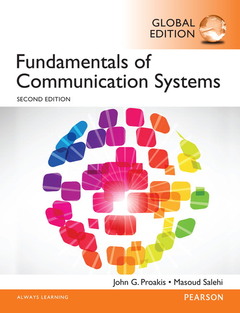Description
Fundamentals of Communication Systems, Global Edition (2nd Ed.)
Authors: Proakis John, Salehi Masoud
Language: English
Subject for Fundamentals of Communication Systems, Global Edition:
Approximative price 99.38 €
In Print (Delivery period: 14 days).
Add to cart928 p. · 17.8x23.3 cm · Paperback
Description
/li>Contents
/li>Comment
/li>
For one- or two-semester, senior-level undergraduate courses in Communication Systems for Electrical and Computer Engineering majors.
This text introduces the basic techniques used in modern communication systems and provides fundamental tools and methodologies used in the analysis and design of these systems. The authors emphasise digital communication systems, including new generations of wireless communication systems, satellite communications, and data transmission networks. A background in calculus, linear algebra, basic electronic circuits, linear system theory, and probability and random variables is assumed.
- 1 Introduction
- 2 Signals and Linear systems
- 3 Amplitude modulation
- 4 Angle modulation
- 5 Probability and random processes
- 6 Effect of noise on analog communication system
- 7 Analog to digital conversion
- 8 Digital modulation methods in an additive white Gaussian noise channel
- 9 Multidimensional digital modulation
- 10 Digital transmission through band limited AWGN channels
- 11 Multicarrier modulation and OFDM
- 12 An introduction to information theory
- 13 Coding for reliable communications
- 14 Data transmission in fading multipath channels
- 15 Spread-spectrum communication systems
- References
- Index
- Emphasis on digital communications—Prepares students for state-of-the-art communication systems.
- Review of the background required for the course in two chapters—Includes one chapter on linear system analysis with emphasis on the frequency domain approach and Fourier techniques, and one chapter on probability, random variables, and random processes.
- Addresses frequent need for students to review these topics in a course on communications; gives students quick access to the relevant material from these courses.
- Computer problems in each chapter that require MATLAB to solve—Gives students experience in simulating communication systems and comparing results with theory.
- A large number of problems in varying levels of difficulty—At the end of each chapter.
- Many worked examples—Help students gain a better understanding of the concepts discussed.
- Two separate chapters on Information Theory and Coding—Provides sufficient emphasis on these key topics.




